 |
Vietnam & Cambodia

We had the wonderful opportunity to do an inland trip with Lisa's parents to visit Vietnam and Cambodia. Poor Bruce had to stay behind to keep an eye on Ohana Kai as there was no room in the inn for her. Whirlwind as the trip was, and tainted with bouts of stomach flu, we were able to fit an amazing amount of sights into a relatively short time and nothing dampened our spirits. If you ever had a desire to experience a whole other world, for relatively little money and do it in comfort and style, this is your place. 6 flights, 5 people, 4 hotels, 3 countries, 2 many buddha's to count and 1 fantastic time.
|
|
 |
|
 |
Vietnam
We made two stops in Vietnam, Hanoi and Ho Chi Minh City or Saigon. There may have been only two cities on the itinerary but a lot of sights were seen.
Ho Chi Minh Mausolelum
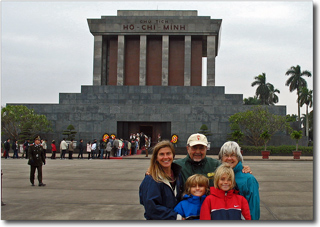
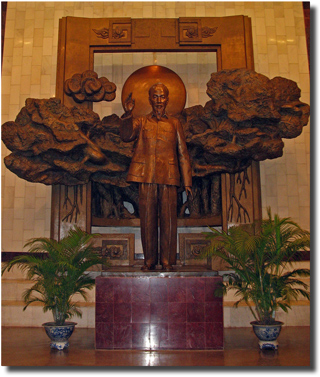
|
|
We hit the ground running as soon as we had the great fortune to be hooked up with the fantastic travel guide service Mekong Discoveries. We can not say enough great things about the services they provide and the amazing professionalism, personal touch and knowledge that their guides possess.
Our first day included the Ho Chi Minh Mausoleum, Ho Chi Minh Museum, the Grand Palace, One Pillar Pagoda, Temple of Literature, Temple of Ethnicity, Sunrise Bridge over Hoan Kiem Lake, and a lovely Vietnamese lunch, whew!
It was a bit surprising and strange to start our day off at the Ho Chi Minh Mausoleum. A gigantic black marble flash cube shaped building with a line the length of a city block of colorfully dressed and playful school children on a typical field trip. We know what a mausoleum is, but somehow it didn't really cross our minds that we would be viewing the man himself, embalmed in a glass chamber, at 9am. Though it was his wish to be cremated, his counselors just couldn't bring themselves to let the his people be without him. Strict dress codes and conduct are required upon entering the building. Just ask Lisa's mom and dad, who were requested to remove a hat and sternly reprimanded for talking inside. Interestingly enough, for three months of the year, he resides in Russia for maintenance. As Tristan says," He looks pretty good for a dead guy."
|
It was amazing to see the respect they continue to hold for Ho Chi Minh himself. On either side of the building are giant billboards reflecting the statements, Long live Ho Chi Minh, Long Live Communism. Within museum are walls and walls of portrayals of him side by side with his people. Each message conveying the themes of peace, and harmony. Every word printed on the walls reads or translates like a Martin Luther King Jr. speech. He never did marry because he believed his country was his bride. He chose not to live in the Grand Palace but rather a beautifully simple small wood stilt home near the grounds to demonstrate that he was one of them. Equally amazing to view was their history timeline and see just how much they have been able to accomplish since President Clinton visited and open up trade with them. Not to mention viewing what they call the "American War" not the Vietnam war from their point of view. Everyone should get to learn history by visiting first hand like this. |
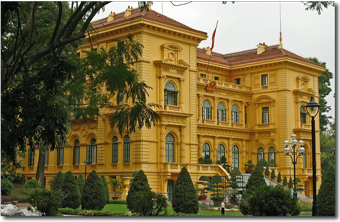
Grand Palace
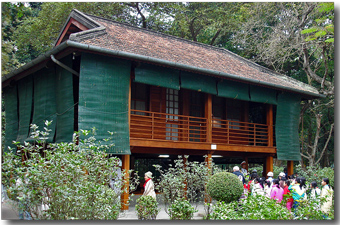
Ho Chi Minh Stilt House |
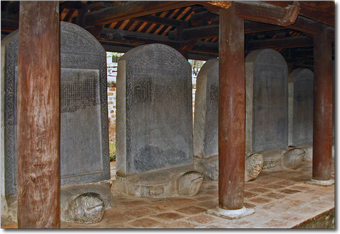 |
The Temple of Literature, Van Mieu, was a peaceful and interesting temple originally and later a university, dedicated to Confucius back in 1070, designed to showcase the best students and scholars of their history dating back to 1442 who had received their doctorates. They can be identified by the 82 headstones, or stelae on top of giant turtles carves out of stone with the many names carved on each headstone attached.
The Temple of Ethnicity was a very well done museum celebrating the diversity and variety of different cultures throughout all of Vietnam. The different designs of homesteads, the array of colors in clothing were very intriguing. |
Hoan Kiem Lake, or Lake of the Returned Sword, stands at the center of the Old Quarter within Hanoi and is the picturesque backdrop for the Ngoc Son Temple or Jade Mountain Temple. Legend states that in the mid 15th century the Emperor Ly Thai To was given a magical sword from heaven that he used to drive the Chinese out of Vietnam. While visiting the lake, a giant tortoise swam up, grabbed the sword in it's mouth and took it to the bottom of the lake for safe keeping and returned it to it's divine owners. A very large embalmed tortoise can be viewed there that is said to be an ancestor of one's that still inhabit the lake today. We have to say that it has the most fascinating face and snout we have ever seen on a tortoise, if anyone could grab a sword it would be him.
We had the great fortune to be treated to lunch with part of our day long tour at the Indochine Restaurant where the delicious food just kept coming. The banana flower and morning glory salad topped a list of many wonderful dishes. The strong French Influence, in architecture, food and language is present every where you turn. |
|
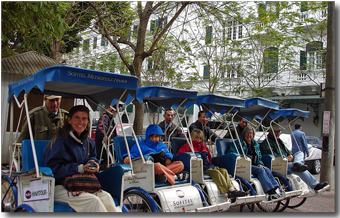
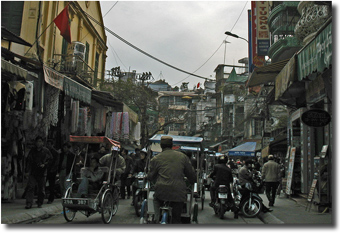
|
Of course no day in Hanoi would be complete without a grand tour in a cyclo. A modern day rickshaw but instead of being pulled you are pushed, and instead of running his poor legs off the kind man peddles you about on a bike. Each of us had our own ride, and it was the most fun and exhilarating E ticket ride to be had through the old town French Quarter.
We slowed it down a bit the next couple of days as a nasty cold and stomach flu took over Lisa's dad. The girls visited the shops, the boys enjoyed the life of Riley inside the extravagant Sheraton hotel. After two and a half years of living in a boat we had died and gone to heaven for the bathtub and showers alone. Though the pool that we had looked so forward to was out of service the entire time, they more than made up for it in the restaurant. Aside from more choices per meal than we had ever been offered in our lives, they had a dessert bar as big as our boat itself, complete with a cascading chocolate fondue fountain. The boys could have never dreamt that one up in their wildest imagination. "Do you think our next boat could have that?" When we left the hotel, the staff actually stopped us personally to thank us for eating every meal with them. |
One more quick stop at some local pottery makers where the boys had a chance to sit with the women and paint their own pieces. The speed and simple beauty with which they make each piece was sensational.
Last but not least, we indoctrinated Lisa's mom and dad into the Visa march. This is where one takes a small task such as obtaining Visa's for another country and turns it into an all day, high speed death march, all over the city, to complete the necessary requirements needed, such as more passport photos, under deadlines that ALWAYS have to be finished within the next 30 minutes. Throw in a flimsy paper map and a foreign language, RUN! |
Tristan painting his pottery. |
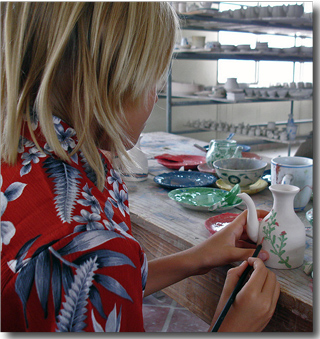 |
|
|
Saigon
We caught a quick flight to Ho Chi Minh City, HCMC or Saigon. Though it's only an hour flight, those girls manage to get full meals out to everyone in style. It almost made you forget the fact that the plane itself felt like it could shimmy apart at any moment.
Saigon itself is a chaotic, noisy city like any other in the sense of the continuous horns honking, hip hop music blaring, scooter revving, cell phones ringing sort of way. The essence that is Vietnam still sneaks through though it may be difficult to see at times behind all the young adults that look more westernized than we did on every corner and store front allowed. It deserved much more time than we had to give so we made the best of our stay with another tour of all the biggest and best spots. |
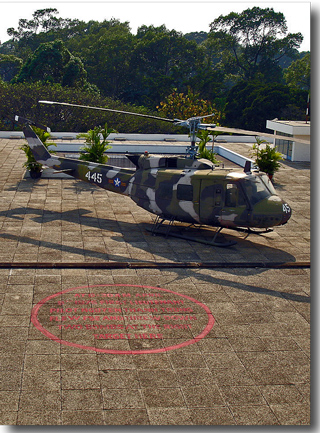
|
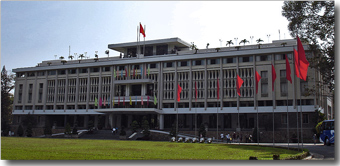
The Reunification Palace was the location that the first communist tanks rushed on the day of Saigon's surrender April 30th, 1975. The building stands exactly today as it did back then and our guided tour revealed all sorts of interesting tidbits of information. The most fun piece though was the helicopter pad one can see from the top floor. The presidents official helicopter pilot at the time was also a double agent, and you can see where he attempted to drop a bomb on the residence and kill the president. (Red circle marks the spot) It was a failed attempt, the man hid in exile for many many years, but today he is the vice president of Vietnam Airlines. Didn't we fly that to come here?
|
Quick stops at the striking St. Joseph's Cathedral, the original Post Office and a very special lacquer shop where they train and employ only people who have become handicapped accidentally by landmine's.
The boys were very brave and respectful as men with no arms would walk up to them and rub their faces with stumps instead of hands in order to provoke sympathy to gain donations.
A stop at the War Remnants Museum, was very thought and emotion provoking. It graphically displayed scenes from the Vietnam/American War such as tiger cages used to house prisoners, artillery pieces, planes, tanks and a difficult section displaying the horrid effects of torture and birth defects from the use of defoliants. To walk amid such recent history in their world and then see their bright resilient faces was powerful. Even stranger still to have a local man walk up and say, "I forgive you."
|
|
Artillery used in Vietnam War |
|
|
It was with great regret that we had to hurry on our way. The rural areas of Vietnams foothills, the Danang Peninsula, "China Beach" and the Mekong Delta begged to be explored but we had to go. Next time.
|
|
Cambodia
As we prepared to board the plane from Saigon to Siem Reap, Cambodia, poor Matthew began his bout with stomach flu that had been passed on from Lisa's Dad. With a collection of airbags from everyone's seat, the trooper made it through the flight with style. Now you ask, what's the fastest way to get into a country?... throw up all over the immigration dude's desk. They'll usher you right in faster than, well, maybe not fast enough for Lisa's poor mom who next to fall victim to the germs. Surprisingly enough, they let us in at all.
The only city we had the chance to visit in Cambodia was Siem Reap, where one of the 7 Wonders of the World resides, Angkor Wat. We had little idea just how much more there was to see, as if that were not enough.

They were, at least to our eyes, making a valiant effort at rebuilding their world and finding creative and ingenious ways to do it. The architecture was bold and striking with a calm beauty all it's own. The food simple and flavorful, the people kind beyond measure. There were no hawkers, there was never pressure, you never had to feel cautious and never felt deceived. They were honest, trustworthy and seemed to go out of their way to take care of you.
|
Life along the Tonle Sap River |
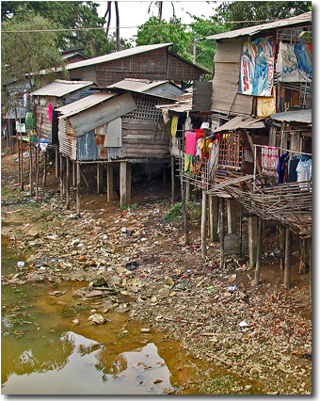 |
|
|
As you take the ride from the airport down the National 6 highway you are sure to be in awe of the sheer numbers of extravagant 5 star hotels that dot the entire journey. We asked around and many of them are built with Cambodian money. We are still not clear where it is coming from or how it was accomplished. None the less, they are putting their best face forward and provided you with exactly what you want. To experience their world from the comfort and style of your own. A huge contrast to the lifestyle that many of them live themselves in poverty. Hands down, the most gentle and gracious people we have met.
So much history in one little country and touching every end of the spectrum.
Vast prosperity and amazing achievements in architecture, irrigation and sculpture under Jayavaraman II-VII, largely due to trade between India and China.
Border wars with neighbors, caught in the crossfire of the Vietnam War, extreme poverty and genocide under the ruling of Pol Pot and the Khmer Rouge.
|
How to rebuild
First and foremost, again, use what you've got. They have the sights and we want to see them. A sweet and patient taxi driver that delivered our sickly bunch to the hotel offered to be our guide around the town when we were well. We took him up on it in a few days and he brought along a spectacular guide to walk us through the wondrous world of mammoth stone temples and the delicious history that created them. It is much more cost efficient and we are sure much easier on the body to try to take this all in over a few days time, but again, time was of the essence for us, so here we go.
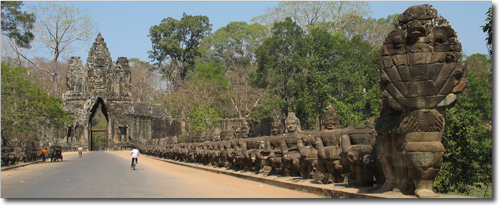
Angkor Thom (Big Angkor) 9 square km of walled and moated city built by one of Angkor's greatest kings Jayavaraman VII, in the very center of the city and the last capital of the Angkorian empire. It is home to the Bayon Temple, Terrace of the Elephants and Terrace of the Leper King just for starters.
|
Bayon Temple
216 enormous Avalokiteshcara faces carved into 37 spires staring out in every direction. Absolutely breathtaking as you feel like someone is always watching over you. Jayavaraman VII's principle temple pieced together over a centuries time in Buddhist tradition.
Equally impressive are the bas-relief carvings on the stone walls throughout containing real life scenes of the battle between the Khmer and the Charm. But most intriguing are the extensive carvings depicting Khmer everyday life from midwives to chess games, wrestling matches to open market, nature and water life.
It is debated whether the faces are of Loksvara or a combination of Buddha and Jayavaraman VII.
Jayavaraman VIII took over and converted the temples to Hinduism, but rather than destroy the striking buddha faces, he had red dots placed on each of the foreheads.
|
|
|
Terrace of Elephants & Terrace of the Leper King
Impressive two and a half meter tall, 300 meter long terraces in the heart of Angkor Thom, that displays some distinct carvings of elephants and garudas. Started by Jayavaraman VII and finished as well by his successors.
|
|
Last but certainly not least. The temple is nearly 1 sq. mile (2.6 km), surrounded by a moat that could possibly have been used for both protection, religious ceremonies and irrigation. It has a pyramidal form that imitates the mythological home of the HIndu gods. Constructed by Suryavaraman II in the form of a massive "temple-mountain" dedicated to the HIndu god Vishnu. It consists of three levels surmounted by a central tower. Inside and out the temples walls are covered in bas relief and carvings. Nearly 2000 distinctively apsara carvings decorate the walls in some of the most detailed art work of the Angkorian era.
The exterior walls of the lower level display the most extraordinary work of all, depicting stories and characters from Hindu mythology and the historical wars of Suryavaraman II. The longer you stay in one spot and stare deeply into the carvings the more items are revealed to you. The details in each aspect of life,emotions, nature, humans, spiritual worlds, life and death are countless. Best of all for us was the complete depiction of the legend of "The Churning of the Ocean Milk" that we had seen previously acted out with puppets in Bangkok. It helped it to all come full circle and make tangible just how connected cultures are.
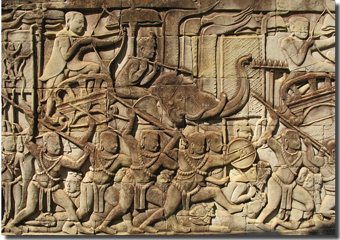
|
Apsara dancer |
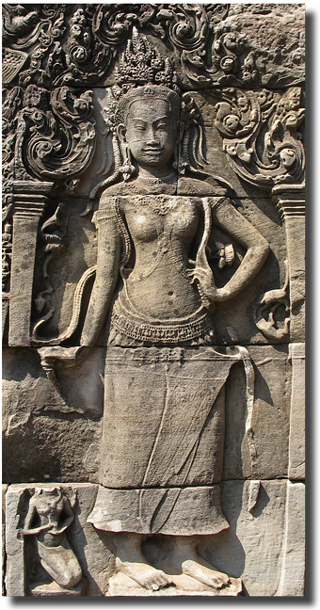 |
|
|
|
Artisans |
Silk worm cocoons building up their threads.

Silk farm and silk weaving, pottery, wood carving, stone carving, lacquer, silk painting are just a few of the artisan trades and traditions being revived and passed on to new generations.
|
In order to find ways to help their people provide for themselves, and maintain the ability to continue to live out in the countryside, many, many non profit foundations and organizations have been set up in the form of artisan schools. The schools go out into the countryside and provide aptitude tests and interviews to see who is truly interested. Upon entrance to the school, you are provided a living stipend and residence if needed, and then all the training for your particular art, be it silk weaving, pottery, wood and stone carving, lacquer and painting, to name just a few. Special attention is given to try to find individuals as well that are handicapped or in special need, for example an entire group of deaf gals who would have no other means to care for themselves financially, all trained in silk painting. Local children are invited to capture butterflies for a local garden/restaurant and come twice a week to release and be paid for their efforts. The money and donations all go to their health care and education.
|
|
|
Silk Farm |
Our first trip was 16 km. outside of town to visit a true working silk worm farm. A fabulous tour provides you the chance to watch the entire process from the mulberry field that holds nearly half a dozen different types of mulberry, each stage of the silk worms growth, harvesting of the silk off the cocoon itself, the dying process and finally the weaving process. All done completely without electricity and all by individual hand after individual hand.
An amazing 400 meter long thread can be procured from each cocoon! The women that are taught the trade learn only one or two new weaving designs each year with emphasis on traditional styles so that the art and history of them is not lost. In the showroom, there are multitudes of differing pieces of their work for sale including bolts and bolts of just the silk fabrics alone.
|
|
Wood and Stone Carving |
Stone Carving and other artisans |
|
|
|
The young men chosen to work here are diligent and precise. They carve tiny elephants to larger than life Apsara dancers or dragons. Again the emphasis is on traditional figures from their historic past but samples of some beautiful modern pieces were stunning as well.
In order to create some of the intricate designs on the figure they lay a paper template over the medium and carve around it. At the end of their training, an artist has the choice to stay on with the foundation or go out and work on their own.
|
There were dozens of other trips we found, one could spend weeks exploring the region and this was just one town. It was a shame to pass so much up. Next time. It was difficult as well to see some of the terrible squalor that so many individuals were living in along the Tonle Sap River while so many others were comfortable tucked into their 5 star hotels across the way. There is comfort in knowing that there is so much being currently done to help revive their livelihood and their country and much to look forward to.
|
|
|
 |
|
|